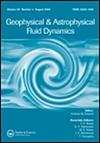螺旋度和缠绕通量作为扭转通量出现的指标
IF 1.1
4区 地球科学
Q3 ASTRONOMY & ASTROPHYSICS
Geophysical and Astrophysical Fluid Dynamics
Pub Date : 2019-09-03
DOI:10.1080/03091929.2020.1740925
引用次数: 9
摘要
迄今为止,太阳大气中出现扭曲通量管的证据来自间接信号。本文通过对螺旋度和缠绕通量的研究,直接研究了扭转磁通管涌现的拓扑输入。在从对流区顶部到下日冕的磁流体动力学模拟中,我们模拟了具有不同初始场强范围的扭曲磁通管的出现。这项工作的一个重要特征是在光球下包含了一个对流不稳定层。我们发现在考虑不同场强的螺旋度输入中近似自相似的行为。当管上升并到达光球时,由于我们考虑的是左旋管,因此有很强的负螺旋度输入。这个阶段之后是负输入的减少,对于较低的初始场强,净正螺旋度输入。这一阶段对应于出露期间对流对油田影响的增强和蛇形油田构造的发育。缠绕磁通可用于检测管的扭曲磁芯何时到达光球,从而提供拓扑复杂磁场输入到太阳大气的清晰信息。简而言之,螺旋度和绕组通量可以提供很多关于磁场如何产生的信息,这些信息不能直接从其他来源获得,例如磁图。在评估这些模拟的螺旋度内容时,我们测试了许多用于创建合成磁图的方法,包括考虑不断变化的几何形状和光球的有限范围的方法。虽然在每种情况下,一般的定性行为是相似的,但不同形式的平均确实会定量地影响螺旋度和绕组输入。本文章由计算机程序翻译,如有差异,请以英文原文为准。
Helicity and winding fluxes as indicators of twisted flux emergence
Evidence for the emergence of twisted flux tubes into the solar atmosphere has, so far, come from indirect signatures. In this work, we investigate the topological input of twisted flux tube emergence directly by studying helicity and winding fluxes. In magnetohydrodynamic simulations with domains spanning from the top of the convection zone to the lower corona, we simulate the emergence of twisted flux tubes with a range of different initial field strengths. One important feature of this work is the inclusion of a convectively unstable layer beneath the photosphere. We find approximately self-similar behaviour in the helicity input for the different field strengths considered. As the tubes rise and reach the photosphere, there is a strong input of negative helicity since we consider left-handed twisted tubes. This phase is then followed by a reduction of the negative input and, for low initial field strengths, a net positive helicity input. This phase corresponds to the growing influence of convection on the field and the development of serpentine field structures during emergence. The winding flux can be used to detect when the twisted cores of the tubes reach the photosphere, giving clear information about the input of topologically complex magnetic field into the solar atmosphere. In short, the helicity and winding fluxes can provide much information about how a magnetic field emerges that is not directly available from other sources, such as magnetograms. In evaluating the helicity content of these simulations, we test numerous means for creating synthetic magnetograms, including methods which account for both the evolving geometry and the finite extent of the photosphere. Whilst the general qualitative behaviours are similar in each case, the different forms of averaging do affect the helicity and winding inputs quantitatively.
求助全文
通过发布文献求助,成功后即可免费获取论文全文。
去求助
来源期刊

Geophysical and Astrophysical Fluid Dynamics
地学天文-地球化学与地球物理
CiteScore
3.10
自引率
0.00%
发文量
14
审稿时长
>12 weeks
期刊介绍:
Geophysical and Astrophysical Fluid Dynamics exists for the publication of original research papers and short communications, occasional survey articles and conference reports on the fluid mechanics of the earth and planets, including oceans, atmospheres and interiors, and the fluid mechanics of the sun, stars and other astrophysical objects.
In addition, their magnetohydrodynamic behaviours are investigated. Experimental, theoretical and numerical studies of rotating, stratified and convecting fluids of general interest to geophysicists and astrophysicists appear. Properly interpreted observational results are also published.
 求助内容:
求助内容: 应助结果提醒方式:
应助结果提醒方式:


